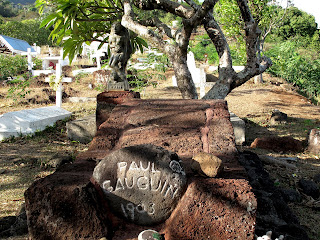We were anchored at Baie Taahuku, where the port is situated. On landing to complete entry formalities with WARC’s agent, Laurent, we were greeted by the tourism authority with leis made of fresh flowers. A nice gesture but if you weren’t wearing a collared shirt, the flowers tended to promote a mild rash around one’s neck. The dinghy landing is rocky, rough and slippery which made every shoreside excursion a bit of an adventure.
Baie Taahuku with Anakee island in the background
Another view of Baie Taahuku
west side of Baie Taahuku
About a 40 minute walk (uphill and downhill) is the town of Atuona – a small place with a post office, a gendarmerie (police station), bank and a couple of decent supermarkets. The bread here is as good as in France as ingredients come all the way from the “mother” land. Along the main street are two graves of Marquesans who fought in WW I and WW II. Up on the hill beyond is the town’s grave yard where Paul Gauguin and Jacques Brel are buried. There is a Gauguin museum featuring reproductions of his work and the Espace Jacques Brel exhibiting Brel’s beloved Beech Twin Bonanza airplane, "Jojo", and other memorabilia. There are a couple of “snack” restaurants along the street. We learned quickly that these are casual eateries serving stuff like hamburgers and steak frite. The “magasins” are small general stores that stock everyday needs and much of the stores' inventory come from France (and are expensive). The supply ship comes from Tahiti every couple of weeks to re- supply the island with anything from food, beverage, construction material to jet fuel for the airport. There is a small airport served by Air Tahiti’s ATR-72s – 72-seat twin turboprops. All quite civilized for an island of less than 2000 people. French and the local language are the lingua franca – very little English is spoken here.
March 26 – the tourism authority provided a formal welcome with traditional dances accompanied by drums and other local instruments like trumpets made from conch shells.
Marquesan welcome at Hiva Oa
The next couple of days were occupied by boat maintenance chores, laundry and walks to Atuona. We had dinner one evening at a hotel overlooking the bay -- the usual rule applies -- good view, mediocre food.
wash day aboard Skylark
I went to the Brel exhibits, the Beech Twin Bonanza airplane being the main attraction.
"Jojo" at the Espace Jacques Brel
Exhibits at Brel museum - his music played softly in the background
March 28 – we shared a rental car with the Mackays, David and Susan, to do some provisioning as well as to drive to the other side of the island for a meal and to visit an old Marquesan "Marai" a sacred burial site. It was an eventful morning. The rental car was a pick-up truck with a crew cab. Two of the boys from another WARC yacht, Ronja, asked for a ride to the supermarket and rode in the flat bed of the pick-up. After much shopping at the supermarket, we were accosted by a dour, officious gendarme (French, of course) who told David that he’d committed a serious offence in having two passengers in the back of the truck. To cut a long story short, we were led to the gendarmerie where David was processed for the “offence” resulting in a 8100 CFP fine and half melted frozen supermarket purchases. It spoilt the day especially for Susan. We all felt the gendarme was unduly harsh to a visitor who was unaware of the rules. In any event, God didn’t endow him with good looks and he’ll probably be a policeman for the rest of his life…
The rest of the day was fun as we drove the only road to the other side of the island through the rugged terrain and some unpaved roads. We had a nice lunch at the restaurant Marie Antoinette, which was situated near the burial site. We walked past lime, papaya and pampelmousse (a variant of grapefruit) trees, some chickens and goats to get to the marai which featured some very old “tiki’s or human/animistic stone images.
Hiva Oa's spectacular coastline typified by bays such as these
Ed and Francois with the MacKays
a makeshift "Tiki"
Marai at Hiva Oa
A quick visit to the gravesites of Gauguin and Brel and we were back at the port.
The Gauguin grave
...and Brel's
Back on Skylark, we made preparations for our southwards passage to Tahuata and beyond. More in the next post.


























